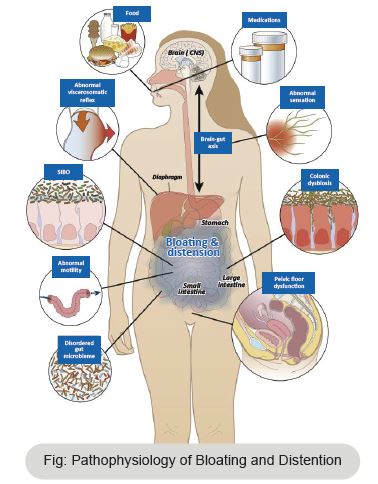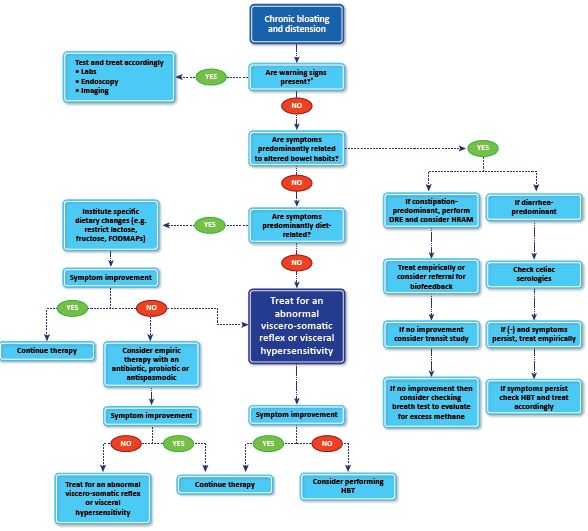Functional abdominal bloating and distention (FABD) is one of the most commonly reported gastric issues to physicians. FABD may be thought of as a sole complaint or may coexist with other functional gastrointestinal disorders such as functional dyspepsia, irritable bowel syndrome, and functional constipation.
Bloating can be defined as a sense of gassiness or a sense of being distended; measurable distention does not have to occur, whereas abdominal distention should be reserved for patients who show a visible increase in abdominal girth.
About 30% of the general adult population report bloating and distention along with IBS. However, half of the people with bloating also report abdominal distention.1 It is noted that bloating is common among patients with IBS, whereas distention is more common in patients with chronic constipation.2

Common causative factors for FABD.
The aetiology of abdominal bloating and distention is multifactorial.
Although it is otien misunderstood that ‘gas’ in GI tract is the
reason for bloating and distention, it is a causal agent in very few cases of
FABD.

1) Increased Intraluminal Content
Intraluminal content includes water, air, gas, and faecal material. Air and gas
may become copious within the lumen through aerophagia and potentially from the
overproduction of gas by colonic or small intestine bacteria.4 Small
intestinal bacterial overgrowth (SIBO), gas under-absorption, and diet high in
fermentable, poorly digested and absorbed carbohydrates may all play a role in
causing FABD.5
2) Visceral Hypersensitivity
Increased gut sensitivity and heightened attention to intraluminal contents may
give rise to functional abdominal bloating and distention. Patients with IBS
have a high awareness of their gut contents and motility and thus may experience
even a slightly modified gut intraluminal content as bloating.6
Malagelada et al. used the term “conscious perception” to explain the role of
the brain-gut axis in symptom generation (abdominal bloating). According to
this model, visceral allodynia (seen also in IBS) is responsible for the
bloating sensation that occurs in the presence of normal or only mildly
increased amounts of intraluminal gas or other bowel content.7

3) Abdomino-Phrenic Dyssynergia
Abdomino-Phrenic Dyssynergia is a term coined by the Barcelona group. It
describes the responses of patients with FABD to a meal. According to the study
by the same group,patients with FABD have a distinguished and abnormal muscle
activity characterised by anterior abdominal wall relaxation and diaphragm
contraction. This activity causes the abdominal gas to redistribute and cause
an anterior wall protrusion with noticeable distention.8
4)
Constipation and Outilow Obstruction
Functional abdominal bloating and distension may be related to constipation and
to functional outilow obstruction. Retained stool in the rectum may cause
impaired gas evacuation and slowing of intestinal transit. Compared with
healthy volunteers, patients with FABD have a slower colonic transit.9
5)
Obesity
Rapid weight gain and weight loss are associated with aggravation and
improvement in bloating, respectively.10 In one study,
recent weight gain coincided with new-onset bloating in 25% of the participants
. A possible mechanism may involve an abnormal viscero-somatic reflex
originating in the abdominal adipose issue which modulates the brain-gut axis,
resulting in FABD.11
6)
Dysbiosis
Aberrant constitution or alteration in colonic microbacteria may lead to
increased production of colonic gas by fermentation or decreased gas
consumption, leading to increased colonic gas content and bloating.12 Collins et al. observed that interruption of the
host–microbiota equilibrium affects the intestinal immune system and leads to
inflammation. This, in turn, leads to gut sensory and motor dysfunction which
may contribute to bloating.13
More recently, Ringel-Kulka et al. studied the relationship between the
intestinal microbiota, abdominal bloating, and altered bowel patterns in a
cohort of patients with IBS and found significant changes in microbiota among
different IBS subtypes. In particular, the authors noted that bloating was
associated with specific microbial taxa.14
As
the pathophysiology of FABD is multifactorial, the treatment of the FABD is
also complex. The reason for FABD needs to be evaluated before one can start
treating it.

Treatment options:
1) Symptomatic management: Antispasmodics and Simethicone can be used
for symptomatic relief.
2) Dietary intervention: The main goal here is to understand the diet of
the patient and what food items the patient is intolerant to. Restriction
of lactose and poorly absorbed carbohydrates is usually one of the initial
steps of dietary intervention.
3) Treatment of constipation: As in most cases,
constipation could be the reason. Medications like Linaclotide and
Pyridostigmine seem to help.
4) Microbiome modulation: Rifaximin and probiotics help in maintaining
healthy gut microbiome.
5) Abdominal biofeedback therapy: Acting on the
diaphragm and abdominal muscles, this therapy helps in treating FABD.16
Abdominal bloating and distention are very common issues which
impose a lot of discomfort. Based on the various studies, the reasons that this
happens could vary from simple dyspepsia to hypothyroidism. Hence, as the
aetiology is multifactorial, the treatment also needs to have a different
approach with one or more lines of management.
Reference: